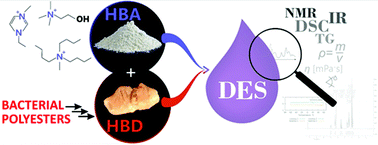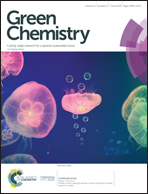Polyhydroxyalkanoate-derived hydrogen-bond donors for the synthesis of new deep eutectic solvents†
Abstract
Bacterial polyesters are a well-known group of polymers with excellent biocompability and biodegradability. They are also a renewable source of a wide array of enantiopure (R)-3-hydroxycarboxylic acids. In this study, a series of ternary deep eutectic solvent (DES) systems were prepared using a mixture of microorganism-derived (R)-3-hydroxynonanoic and (R)-3-hydroxyheptanoic acids in a molar ratio of 7 : 3 as hydrogen-bond donors (HBDs) and selected quaternary ammonium salts as hydrogen-bond acceptors (HBAs), namely choline, 1-ethyl-3-methylimidazolium and tributylmethylammonium chlorides. For comparison, DESs based on aliphatic carboxylic acid analogues, i.e. nonanoic and heptanoic acids, were also studied. The systems were characterised by 1H NMR and FT-IR techniques and the formation of hydrogen bonds between the HBDs and HBAs was proved. The thermal properties, including the melting temperatures and thermal stabilities, as well as the polarity and wetting properties were determined by DSC, TGA, the Nile Red method and dynamic contact angle methods, respectively. The viscosity and density were measured over a temperature range of 30–60 °C. Cytotoxicity and biodegradation studies were conducted and revealed the non-toxic character of the choline-based DES. The ability of the DESs to dissolve lignin was also evaluated. The results demonstrated the potential for a new area of application of bacterial polyesters for the synthesis of novel bio-based solvents.



 Please wait while we load your content...
Please wait while we load your content...